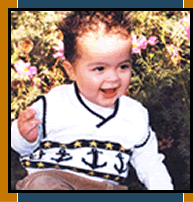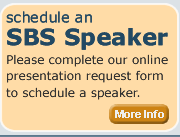

Sign up to receive periodic e-mail alerts, SBS news and special announcements...

|
Shaken baby Syndrome often tough to detect - until it's too late There are no bruises on this baby's skin. No cuts or scabs. No broken bones. Hunter Rodriguez looks like a normal 15-month-old - on the outside. Inside, his swollen brain is slowly recovering. Blood vessels in his head and neck have been sheared, permanently damaging his motor skills. Bleeding behind the eyes has impaired his vision. Hunter's injuries were shaken into him. So were Jonah Ruiz's of Greeley, who died at 2 months. And Steven Washburn's of Black Forrest, who can't walk at age 3. The list grows longer every month, filled with victims of shaken-baby syndrome. Doctors at Denver's Children's Hospital who nursed Hunter out of his coma see 20 to 40 infants a year with this kind of head trauma. Their injuries vary greatly. Some children die. Others will never walk or talk. Those whose brains weren't as severely damaged might still suffer learning disabilities. Shaken baby syndrome is not new. The term was coined in the 1970's and became commonly used in the early 1990's. Pubic-education campaigns have raised parents' awareness about shaken baby syndrome. So did the highly publicized trial of British au pair Louise Woodward, convicted of manslaughter in shaking an 8-month old Massachusetts' boy to death. Yet dying or damaged infants keep turning up in emergency rooms, giving doctors little hope that the problem is lessening. "A lot of people still have not idea that shaking can cause severe injury or death in children." said Dr Jacy Showers, who directs the program Shaken Baby Syndrome Prevention Plus in Florence. "People have learned they're not supposed to hit their kids, but shaking is different. There's no blood. They look perfectly normal on the outside." Doctors are now learning that they, too often overlook these hidden injuries. Researchers at Children's Hospital studied 173 cases of abusive head trauma in children from 1990 to 1994. Of those, 31 children had been previously treated for symptoms of shaking, but doctors had failed to detect that the babies had been abused. "We didn't realize how frequently we miss this." said Dr. Carole Jenny, who conducted the Children's Hospital study. She's now a professor of pediatrics at Brown University. "It's very difficult to diagnose in kids," Jenny said. Doctors are working to become more sensitive to early signs. They want to find better ways to distinguish a baby's cold or flu from symptoms of shaking. Shaken babies are bundled into hospitals with symptoms that vary dramatically. Babies with less severe shaking injuries appear, at first, to have the flu. They're vomiting. They're irritable. They have a slight fever and won't stop crying. "They don't show up on physical exam or CT scan. You don't make the diagnosis until the next time they come in dead," said Dr. Mary Macentee, a pediatric intensive care specialist at Presbyterian/St. Luke's Medical Center, which treats one or two shaken babies a month. About 25 percent to 30 percent of shaken babies, like Jonah Ruiz, die. Most times, babies are shaken between 2 months and 4 months of age. But children as old as 4 have been killed by shaking. Showers said she's known of women - victims of domestic violence - who've suffered retinal and subdural hemorrages, signs of the syndrome in adults. Generally, babies less that 6 months old are most vunerable. Jenny gave this analogy: "Imagine, you have a 2,500 pound monster come and pick you up and shake you violently, somebody who was mad at you." Dr. Andy Sirotnak, director of the Kempe Child Protection Team at Children's Hospital, compared the damage to a stroke in an adult. "If the infant survives, parts of the brain have been permanently injuried or disabled," he said. Babies' neck muscles are weak, and their heads are large and heavy compared to their bodies. That's why anyone holding a baby is supposed to place a gentle hand under its floppy head until those neck muscles firm up. Also, infants have more water and less fat around their brains than adults do. Their brains can move within their skulls. When a baby is violently shaken, blood vessels in the brain tear. That leads to subdural bleeding, then swelling in the brain. It's akin to an adult being thrown from a car, or suffering whiplash in a car accident. Shakes also tear a baby's retinas. This can lead to blindness. Shaken babies who survive don't grow and learn like normal children. Some can never hold crayons or kick soccer balls. Others might develop some physical skills but have learning disabilities and behavioral problems. Babies are almost always shaken in anger. It's a flash of violence at a tiny, defenseless target making noise. It's not bouncing a baby on your knee, or playing Ring Around the Rosy with a toddler. "Infant swings don't do it. Walkers don't do it. It's a violent shaking of a child's head," Sirotnak said. In recent Colorado cases, police have arrested child care workers. Jacqueline Rodriguez had been taking Hunter to baby sitter Shawna Pint, less than 3 months when Pint was charged with child abuse. Hunter went home Nov. 20. He improved remarkably since he came to the hospital, Oct. 19. But doctors don't know if his brain will fully recover. "He was so outgoing, so good, so happy." his mother remembers. "He hardly ever cried... He'd go out to our garden and pull off tomatoes and strawberries and eat them and eat dirt." Now his days are filled with therapy. "He basically has to learn to roll over again, just like when he was an infant... learn how to crawl again, hopefully walk again, just start all over," said Hunter's father, Greg Rodriguez.
|

Home | Hunter's Story | News Articles | Presentations | FAQ's | Resources | Contact
Site by NolanDigitalArts.com